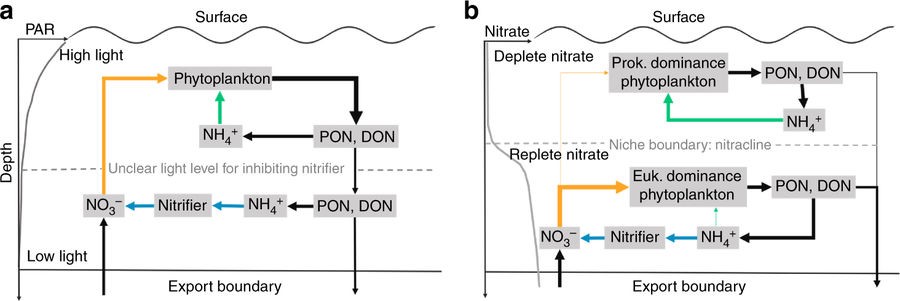2018年3月2日,我实验室高树基研究团队在Nature Communications期刊在线发表题为“Ambient nitrate switches the ammonium consumption pathway in the euphotic ocean”的研究论文,以现场原位速率观测与环境因子调查,证明了环境硝酸盐浓度是调控海洋真光层不同氨氮消耗途径的关键因子。硝酸盐通过影响浮游植物对于氨氮吸收的能力,决定了真光层内氨氮的氧化路径强弱,刻画了海洋真光层氮循环的微结构。
浮游植物吸收和硝化是海洋氨氮的两条关键转化途径,其中硝化作用是将氨氮逐级氧化为硝酸盐的过程,链接着海洋氮素的迁入和迁出,是氮循环核心的代谢路径之一。传统认为硝化微生物在真光层受到光抑制作用,因此真光层的氨氮归宿以浮游植物吸收主导,而硝化作用则活跃于真光层底部和无光层(图1-a)。近年来,一类新型的氨氧化古菌(AOA)被发现大量存在并活跃于海洋真光层内部,直接颠覆了该传统认知。然而在全球不同海区的真光层硝化观测,显示出矛盾冲突的时空分布特点,没有有效的理论来解释这种矛盾。
高树基团队利用同位素示踪培养技术,围绕南海和西北太平洋真光层内硝化作用和浮游植物氨氮吸收速率的垂直分布特点及其动力学特征进行研究。首次提出硝酸盐浓度通过影响不同浮游植物类群对于氨氮的吸收能力,从而调控真光层的氨氮消耗途径。在寡营养盐的混合层内,由于以原核藻类为主的浮游植物群落对于氨氮有着高亲和力,并且光部分抑制了硝化微生物,导致浮游植物吸收成为主要的氨氮消耗路径。而在硝酸盐跃层及以下,浮游植物群落的演替和其营养盐利用策略的改变,使得周边高浓度的硝酸盐成为主要氮源,同时下调了自身对于氨氮的亲和力,从而使得氨氧化微生物成为氨氮竞争的优胜者(图1-b)。这一发现不仅从根本上解决了长久以来硝化微生物的光抑制假说与近来发现真光层存在活跃的硝化行为这一矛盾现象,而且为更深入、精确地理解和预测硝化作用与新生产力的空间耦合关系,同时为评估海洋真光层内潜在的氧化亚氮来源和通量,提供新的理论支撑。

图1 光区硝化作用调控机制的示意图。a:传统光控假说;b:基于本文提出的新机制。(绿色箭头与黄色箭头分别代表氨吸收与硝酸盐吸收,蓝色箭头则为硝化过程。)
研究团队的万显会博士为成果的第一作者,特聘教授高树基为通讯作者,实验室戴民汉教授,史大林教授、张瑶教授、盛华夏博士后、祝依凡,以及澳大利亚联邦科学与工业研究组的Tom Trull教授和美国Bigelow海洋实验室的Mike Lomas教授为成果的共同完成人。成果获得了国家重点基础研究发展计划(2014CB953702, 2015CB954003),国家自然科学基金委“创新研究群体项目”(41721005)以及重点基金项目(91328207)的资助。
Citation:Xianhui Sean Wan, Hua-Xia Sheng, Minhan Dai, Yao Zhang, Dalin Shi, Tom Trull, Yifan Zhu, Mike Lomas, Shuh-Ji Kao*. Ambient nitrate switches the ammonium consumption pathway in the euphotic ocean, Nature Communications, 2018, 9 (1): 915. doi: 10.1038/s41467-018-03363-0.
全文链接:https://www.nature.com/articles/s41467-018-03363-0
Abstract: Phytoplankton assimilation and microbial oxidation of ammonium are two critical conversion pathways in the marine nitrogen cycle. The underlying regulatory mechanisms of these two competing processes remain unclear. Here we show that ambient nitrate acts as a key variable to bifurcate ammonium flow through assimilation or oxidation, and the depth of the nitracline represents a robust spatial boundary between ammonium assimilators and oxidizers in the stratified ocean. Profiles of ammonium utilization show that phytoplankton assemblages in nitrate-depleted regimes have higher ammonium affinity than nitrifiers. In nitrate replete conditions, by contrast, phytoplankton reduce their ammonium reliance and thus enhance the success of nitrifiers. This finding helps to explain existing discrepancies in the understanding of light inhibition of surface nitrification in the global ocean, and provides further insights into the spatial linkages between oceanic nitrification and new production.